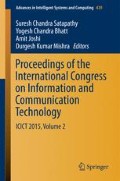Abstract
Nowadays there is a huge increase in the use of sensors in various applications such as remote monitoring of environment, automobiles, disaster prone zones, home control, and military applications. The capabilities of Wireless Sensor Network (WSN) can be extended using self-organization to change their behavior dynamically and achieve network wide characteristics. Clustering techniques show the self-organized behavior of WSNs. Sensor nodes are grouped into disjoint, nonoverlapping subsets called clusters. Cluster Heads (CHs) collect data from the sensor nodes present in the cluster and forward it to the neighboring nodes using shortest path distance calculation and finally to the Base Station (BS). In the proposed clustering technique, network area is divided into regions. Cluster Head (CH) is elected by using the highest residual energy and the node degree. Cluster communication is at the most two-hop which results in less number of messages from member nodes to BS. Within a cluster, data is sent to CH by member nodes. After some time CH’s energy level goes below threshold value, then new CH is elected and clusters are reformed within each region. Our proposed clustering technique can be used in military applications to detect and gain information about enemy movements. Results are obtained by varying the number of nodes at different transmission ranges. The simulation results show that the proposed clustering algorithm reduces energy consumption, prolongs network lifetime, and achieves scalability.
Access this chapter
Tax calculation will be finalised at checkout
Purchases are for personal use only
References
Krishna Doddapaneni, Fredrick A. Omondi, Enver Ever, Purav Shah, Orphan Gemikonakli, Roberto Gagliardi.: Deployment Challenges and Developments in Wireless SensorNetworks Clustering, 24th International Conference on AINA Workshops, IEEE (2014).
Naveen Sharma and A. Nayyar.: A Comprehensive Review of Cluster Based Energy Efficient Routing Protocols for Wireless Sensor Networks, IJAIEM, Volume 3, Issue 1, January (2014).
Wendi B. Heinzelman, Anantha P. Chandrakasan, Hari Balakrishnan.: An Application-Specific Protocol Architecture for Wireless Micro-sensor Networks, IEEE Transactions on volume 1, issue 4, pp. 660–670 (2002).
K. Latif, A. Ahmad, N. Javaid, Z.A. Khan, N. Alrajeh.: Divide-and-Rule Scheme for Energy Efficient Routing in Wireless Sensor Networks, 4th International Conference on ANT 2013, Published by Elsevier (2013).
Navin Gautam, Won-Il Lee and Jae-Young Pyun.: Dynamic Clustering and Distance Aware Routing Protocol for Wireless Sensor Networks, ACM Spain, pages 9–14, (2009–2010).
Babu N V, Puttamadappa. C, Bore Gowda S B.: Energy Efficient Two Hop Clustering for Wireless Sensor Networks, IJCSNS International journal of Computer Science and Network Security, vol. 13 no. 9, September (2013).
Vaibhav Deshpande, Arvind R. Bhagat Patil.: Energy Efficient in Wireless Sensor Network Using Cluster of Cluster Heads, IEEE (2013).
Ossama Younis and Sonia Fahmy.: HEED: A Hybrid, Energy-Efficient, and Distributed Clustering Approach for Ad Hoc Sensor Networks, IEEE transaction on Mobile Computing, vol. 3, no. 4, October–December (2004).
Author information
Authors and Affiliations
Corresponding author
Editor information
Editors and Affiliations
Rights and permissions
Copyright information
© 2016 Springer Science+Business Media Singapore
About this paper
Cite this paper
Kalyani Wankhede, Sumedha Sirsikar (2016). Region-Based Clustering Approach for Energy Efficient Wireless Sensor Networks. In: Satapathy, S., Bhatt, Y., Joshi, A., Mishra, D. (eds) Proceedings of the International Congress on Information and Communication Technology. Advances in Intelligent Systems and Computing, vol 439. Springer, Singapore. https://doi.org/10.1007/978-981-10-0755-2_13
Download citation
DOI: https://doi.org/10.1007/978-981-10-0755-2_13
Published:
Publisher Name: Springer, Singapore
Print ISBN: 978-981-10-0754-5
Online ISBN: 978-981-10-0755-2
eBook Packages: EngineeringEngineering (R0)

